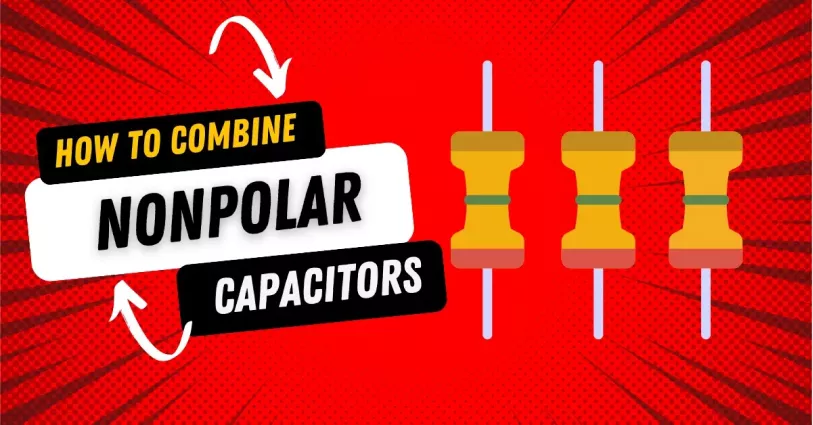Non-polar capacitors are types of capacitors that do not have a specific polarity, meaning they can be connected to a circuit in either direction without causing damage. Unlike electrolytic capacitors or tantalum capacitors, which are polarized and have a positive and negative terminal, non-polar capacitors are not limited to a specific orientation during installation.

Non-polar capacitors can be made from various dielectric materials, such as ceramic, film, or certain types of electrolytic capacitors designed to be non-polarized. These capacitors are commonly used in audio circuits, timing circuits, coupling, and decoupling applications where there is no strict polarity requirement.
Non-polar capacitors are advantageous in circuits where the voltage applied may reverse or where maintaining a specific orientation for the capacitor is difficult or not feasible. It simplifies circuit design and installation since the capacitors can be connected in any direction without worrying about polarity issues.
Overall, non-polar capacitors offer greater flexibility in circuit design and application compared to polarized capacitors, making them suitable for a wide range of electronic projects and applications.
How to Combine NonPolar Capacitors
Combining non-polar capacitors in electronic circuits can be done to achieve the desired capacitance value or voltage rating. When combining non-polar capacitors, it is essential to consider the total capacitance and voltage requirements of the circuit. Here are some common methods for combining non-polar capacitors:
-
Series Connection:
-
When connecting non-polar capacitors in series, the total capacitance decreases while the voltage rating adds up. The formula for calculating the total capacitance in series is:
[ \dfrac{1}{{C_{\text{total}}} }= \dfrac{1}{{C_1}} + \dfrac{1}{{C_2}} + \dfrac{1}{{C_3}} + \dots ]
-
Make sure the voltage ratings of the capacitors are not exceeded when connected in series. The voltage across each capacitor will be divided according to the capacitance values.
-
-
Parallel Connection:
- Connecting non-polar capacitors in parallel increases the total capacitance while maintaining the voltage rating of an individual capacitor. The total capacitance in parallel is the sum of the capacitance values of the individual capacitors.
[ C_{\text{total}} = C_1 + C_2 + C_3 + \dots ]
- Ensure that all capacitors in parallel have the same voltage rating as the highest-rated capacitor.
-
Combination of Series and Parallel:
- A combination of series and parallel connection of non-polar capacitors can be used to achieve specific capacitance values and voltage ratings not attainable with individual capacitors.
-
Matching Capacitance Tolerances:
- When combining capacitors, it is important to consider the tolerance of each capacitor. Capacitors with the same tolerance value are preferred to ensure consistent performance.
-
Decoupling and Filtering Applications:
- Non-polar capacitors are commonly used for decoupling and filtering applications in electronic circuits to reduce noise and stabilize power supplies.
-
Consider Circuit Requirements:
- Always consider the specific requirements of the circuit, such as the frequency response, voltage regulation, and transient response, when selecting and combining non-polar capacitors.
When combining non-polar capacitors, it is essential to follow the manufacturer's specifications, ensure proper voltage ratings, and consider the overall capacitance value needed for the circuit. Adhering to these guidelines will help maintain the integrity and performance of the electronic circuit.
Additional Tips and Safety Precautions
When combining non-polar capacitors or any electronic components in circuits, it is crucial to follow additional tips and safety precautions to ensure proper functionality, reliability, and safety. Here are some extra tips and precautions to keep in mind:
Additional Tips:
-
Matching Characteristics: Opt for capacitors with similar temperature coefficients and characteristics to ensure uniform performance across all components.
-
Avoid Voltage Imbalance: When using capacitors in series, ensure that the voltage across each capacitor is balanced to prevent overvoltage on individual capacitors.
-
Temperature Consideration: Be aware of the operating temperature range of the capacitors to avoid performance degradation or failure under extreme temperatures.
-
Avoid Mechanical Stress: Capacitors are sensitive to mechanical stress. Handle them carefully to prevent damage to their structure, leads, or terminals.
-
Stay Within Specified Limits: Operating capacitors outside of their specified voltage, temperature, or frequency ranges can lead to premature failure or safety hazards.
-
Bypass Capacitors: Use bypass capacitors in combination with larger capacitors to filter noise and stabilize voltage levels in sensitive circuits.
Safety Precautions:
-
Discharge Capacitors: Always ensure that capacitors are fully discharged before handling to prevent electric shock or accidental discharge.
-
Proper Polarity: Even though non-polar capacitors do not have polarity, ensure that other components in the circuit, such as electrolytic capacitors, are properly oriented to prevent damage.
-
Safety Gear: When working with electronic components, consider using appropriate safety gear like gloves and safety glasses to protect yourself from any potential hazards.
-
Power Off: Before assembling or modifying a circuit, always turn off the power and unplug the device to prevent electric shock or damage to components.
-
Testing Procedures: Test the circuit carefully after combining capacitors to ensure proper functionality and performance before full operation.
-
Quality Components: Use high-quality capacitors from reputable manufacturers to ensure reliability and performance.
-
Follow Guidelines: Adhere to design guidelines, datasheets, and specifications provided by the capacitor manufacturer to prevent circuit malfunctions and ensure longevity.
By following these additional tips and safety precautions, you can enhance the performance of your circuit, mitigate potential risks, and ensure a safe working environment when working with non-polar capacitors or any electronic components.


